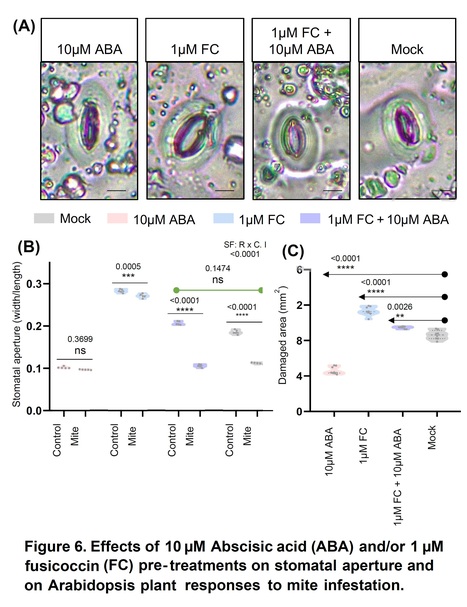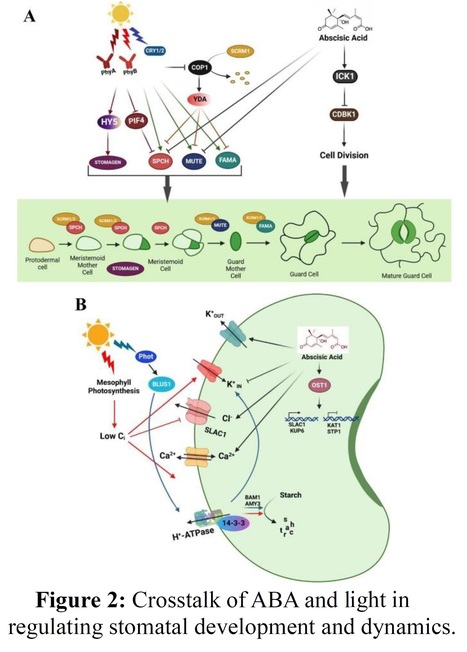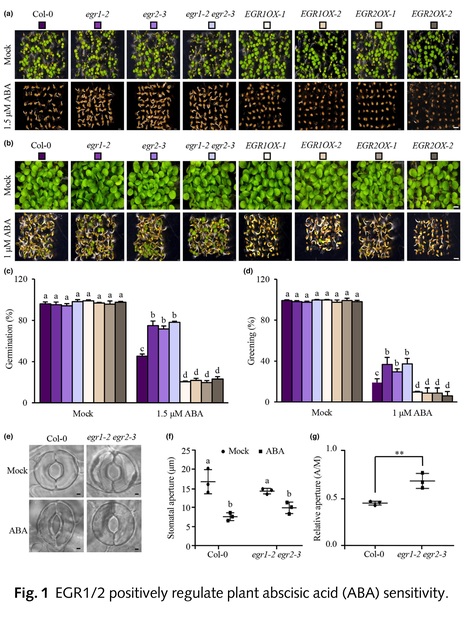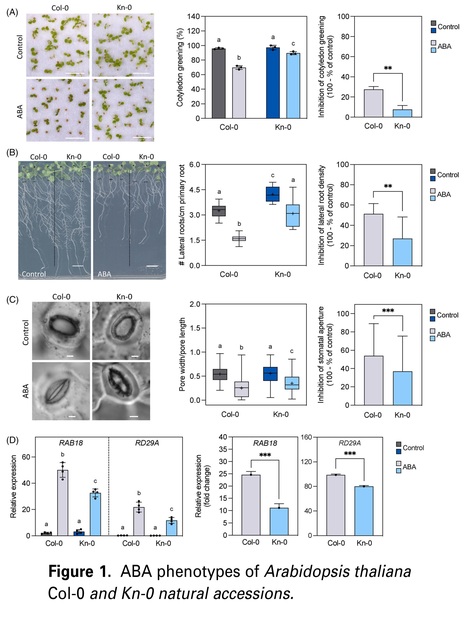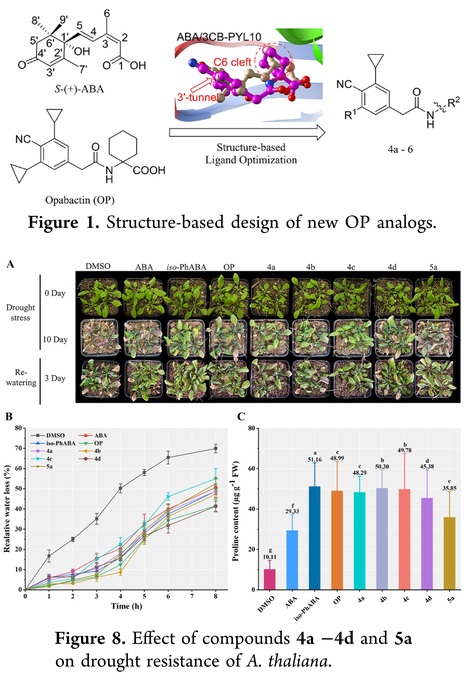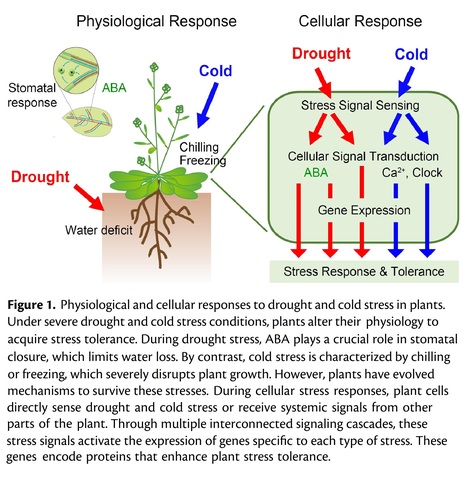 Your new post is loading...
 Your new post is loading...
Authors: Irene Rosa-Díaz, James Rowe, Ana Cayuela-Lopez, Vicent Arbona, Isabel Díaz and Alexander M. Jones.
Plant Physiology (2024)
One-sentence summary: Arabidopsis thaliana employs abscisic acid–induced stomatal closure as an effective defense mechanism against Tetranychus urticae infestation.
Abstract: "Arthropod herbivory poses a serious threat to crop yield, prompting plants to employ intricate defense mechanisms against pest feeding. The generalist pest two-spotted spider mite (Tetranychus urticae) inflicts rapid damage and remains challenging due to its broad target range. In this study, we explored the Arabidopsis (Arabidopsis thaliana) response to T. urticae infestation, revealing the induction of abscisic acid (ABA), a hormone typically associated with abiotic stress adaptation, and stomatal closure during water stress. Leveraging a FRET-based ABA biosensor (nlsABACUS2-400n), we observed elevated ABA levels in various leaf cell types post-mite feeding. While ABA's role in pest resistance or susceptibility has been debated, an ABA-deficient mutant exhibited increased mite infestation alongside intact canonical biotic stress signaling, indicating an independent function of ABA in mite defense. We established that ABA-triggered stomatal closure effectively hinders mite feeding and minimizes leaf cell damage through genetic and pharmacological interventions targeting ABA levels, ABA signaling, stomatal aperture, and density. This study underscores the critical interplay between biotic and abiotic stresses in plants, highlighting how the vulnerability to mite infestation arising from open stomata, crucial for transpiration and photosynthesis, reinforces the intricate relationship between these stress types."
Authors: Kalyan Mahapatra, Shubhi Dwivedi, Arpan Mukherjee, Ajar Anupam Pradhan, Kavuri Venkateswara Rao, Deeksha Singh, Lavanya Bhagavatula and Sourav Datta.
Journal of Experimental Botany (2024)
Abstract: "The exogenous light cues and the phytohormone Abscisic acid (ABA) regulate several aspects of plant growth and development. In recent years, the role of the crosstalk between the light and ABA signaling pathways in regulating different physiological processes has become increasingly evident. This includes the regulation of germination and early seedling development, control of stomatal development and conductance, growth and development of roots, buds, branches, and regulation of flowering. Light and ABA signaling cascades have various convergence points at both DNA and protein levels. The molecular crosstalk involves several light signaling factors like HY5, COP1, PIFs and BBXs that integrate with ABA signaling components like the PYL receptors and ABI5. Especially, ABI5 and PIF4 promoters serve as key “hotspots” for the integration of these two pathways. Plants acquired both light and ABA signaling pathways before they colonized land almost 500 million years ago. In this review, we discuss the recent advances in the interplay of light and ABA signaling regulating plant development and provide an overview of the evolution of these two pathways."
Authors: Jinpeng Li, Xingbei Liu, Shumin Chang, Wei Chu, Jingchen Lin, Hui Zhou, Zhuoran Hu, Mancang Zhang, Mingming Xin, Yingyin Yao, Weilong Guo, Xiaodong Xie, Huiru Peng, Zhongfu Ni, Qixin Sun, Yu Long and Zhaorong Hu.
Science Advances (2024)
One-sentence summary: TaNHX2 exerts flexible role in stomatal response under drought stress via modulating GABA accumulation in wheat.
Abstract: Drought is a major global challenge in agriculture that decreases crop production. γ-Aminobutyric acid (GABA) interfaces with drought stress in plants; however, a mechanistic understanding of the interaction between GABA accumulation and drought response remains to be established. Here we showed the potassium/proton exchanger TaNHX2 functions as a positive regulator in drought resistance in wheat by mediating cross-talk between the stomatal aperture and GABA accumulation. TaNHX2 interacted with glutamate decarboxylase TaGAD1, a key enzyme that synthesizes GABA from glutamate. Furthermore, TaNHX2 targeted the C-terminal auto-inhibitory domain of TaGAD1, enhanced its activity, and promoted GABA accumulation under drought stress. Consistent with this, the tanhx2 and tagad1 mutants showed reduced drought tolerance, and transgenic wheat with enhanced TaNHX2 expression had a yield advantage under water deficit without growth penalty. These results shed light on the plant stomatal movement mechanism under drought stress and the TaNHX2-TaGAD1 module may be harnessed for amelioration of negative environmental effects in wheat as well as other crops."
Authors: Yang Yang, Yan-Qiu Tan, Xinyong Wang, Jia-Jun Li, Bo-Ya Du, Meijun Zhu, Pengcheng Wang and Yong-Fei Wang.
The Plant Cell (2024)
Abstract: "Multiple cyclic nucleotide-gated channels (CNGCs) are abscisic acid (ABA)-activated Ca2+ channels in Arabidopsis (Arabidopsis thaliana) guard cells. In particular, CNGC5, CNGC6, CNGC9, and CNGC12 are essential for ABA-specific cytosolic Ca2+ signaling and stomatal movements. However, the mechanisms underlying ABA-mediated regulation of CNGCs and Ca2+ signaling are still unknown. In this study, we identified the Ca2+-independent protein kinase OPEN STOMATA1 (OST1) as a CNGC activator in Arabidopsis. OST1-targeted phosphorylation sites were identified in CNGC5, CNGC6, CNGC9 and CNGC12. These CNGCs were strongly inhibited by Ser-to-Ala mutations and fully activated by Ser-to-Asp mutations at the OST1-targeted sites. The overexpression of individual inactive CNGCs (iCNGCs) under the UBIQUITIN10 promoter in wild-type Arabidopsis conferred a strong dominant-negative-like ABA-insensitive stomatal closure phenotype. In contrast, expressing active CNGCs (aCNGCs) under their respective native promoters in the cngc5-1 cngc6-2 cngc9-1 cngc12-1 quadruple mutant fully restored ABA-activated cytosolic Ca2+ oscillations and Ca2+ currents in guard cells, and rescued the ABA-insensitive stomatal movement mutant phenotypes. Thus, we uncovered that ABA elicits cytosolic Ca2+ signaling via an OST1–CNGC module, in which OST1 functions as a convergence point of the Ca2+-dependent and -independent pathways in Arabidopsis guard cells."
Authors: Chen Zhao, Jingjing Ma, Chen Yan, Yu Jiang, Yaohua Zhang, Yudan Lu, Ye Zhang, Suxin Yang, Xianzhong Feng and Jun Yan.
The Crop Journal (2024)
Abstract: "Drought stress limits agricultural productivity worldwide. Identifying and characterizing genetic components of drought stress-tolerance networks may improve crop resistance to drought stress. We show that the regulatory module formed by miR166 and its target gene, ATHB14-LIKE, functions in the regulation of drought tolerance in soybean (Glycine max). Drought stress represses the accumulation of miR166, leading to upregulation of its target genes. Optimal knockdown of miR166 in the stable transgenic line GmSTTM166 conferred drought tolerance without affecting yield. Expression of ABA signaling pathway genes was regulated by the miR166-mediated regulatory pathway, and ATHB14-LIKE directly activates some of these genes. There is a feedback regulation between ATHB14-LIKE and MIR166 genes, and ATHB14-LIKE inhibits MIR166 expression. These findings reveal that drought-triggered regulation of the miR166-mediated regulatory pathway increases plants drought resistance, providing new insights into drought stress regulatory network in soybean."
Authors: Md Mahadi Hasan, Xu-Dong Liu, Guang-qian Yao, Jianquan Liu and Xiang-Wen Fang.
Journal of Experimental Botany (2024)
Abstract: "Ethylene, a plant hormone that significantly influences both plant growth and response to stress, plays a well-established role in stress signaling. However, its impact on stomatal opening and closure during dehydration and rehydration remains relatively unexplored and is still debated. Exogenous ethylene has been proven to induce stomatal closure through a series of signaling pathways, including the accumulation of reactive oxygen species (ROS), subsequent synthesis of nitric oxide (NO) and hydrogen sulfide (H2S), and SLOW ANION CHANNEL-ASSOCIATED 1 (SLAC1) activation. Thus, it has been suggested that ethylene might function to induce stomatal closure synergistically with abscisic acid (ABA). Furthermore, it has also been shown that increased ethylene can inhibit ABA- and jasmonic acid (JA)-induced stomatal closure, thus hindering drought-induced closure during dehydration. Simultaneously, other stresses, such as chilling, ozone pollution and K+ deficiency, inhibit drought and ABA-induced stomatal closure through an ethylene synthesis dependent way. However, ethylene has been shown to take on an opposing role during rehydration, preventing stomatal opening in the absence of ABA through its own signaling pathway. These findings offer novel insights into the function of ethylene in stomatal regulation during dehydration and rehydration, gaining a better understanding of the mechanisms underlying ethylene-induced stomatal movement in seed plants."
Authors: Zhangshuai Yang, Guanyu Liang, Chenxu Liu, Zhaohui Chu and Ning Li.
Plant Cell Reports (2024)
Key message The maize F-box protein ZmFBL41 targets abscisic acid synthase 9-cis-epoxycarotenoid dioxygenase 6 for degradation, and this regulatory module is exploited by Rhizoctonia solani to promote infection.
Abstract: "F-box proteins are crucial regulators of plant growth, development, and responses to abiotic and biotic stresses. Previous research identified the F-box gene ZmFBL41 as a negative regulator of maize (Zea mays) defenses against Rhizoctonia solani. However, the precise mechanisms by which F-box proteins mediate resistance to R. solani remain poorly understood. In this study, we show that ZmFBL41 interacts with an abscisic acid (ABA) synthase, 9-cis-epoxycarotenoid dioxygenase 6 (ZmNCED6), promoting its degradation via the ubiquitination pathway. We discovered that the ectopic overexpression of ZmNCED6 in rice (Oryza sativa) inhibited R. solani infection by activating stomatal closure, callose deposition, and jasmonic acid (JA) biosynthesis, indicating that ZmNCED6 enhances plant immunity against R. solani. Natural variation at ZmFBL41 across different maize haplotypes did not affect the ZmFBL41–ZmNCED6 interaction. These findings suggest that ZmFBL41 targets ZmNCED6 for degradation, leading to a decrease in ABA levels in maize, in turn, inhibiting ABA-mediated disease resistance pathways, such as stomatal closure, callose deposition, and JA biosynthesis, ultimately facilitating R. solani infection."
Authors: Haixia Qin, Wenqi Yang, Zile Liu, Yi Ouyang, Xiao Wang, Haiyang Duan, Bing Zhao, Shujie Wang, Junli Zhang, Yuankai Chang, Kun Jiang, Ke Yu and Xuebin Zhang.
Plant Physiology (2024)
Abstract: "In Arabidopsis (Arabidopsis thaliana), stomatal closure mediated by abscisic acid (ABA) is redundantly controlled by ABA receptor family proteins (PYRABACTIN RESISTANCE 1 [PYR1]/PYR1-LIKE [PYLs]) and subclass III SUCROSE NONFERMENTING 1 (SNF1)-RELATED PROTEIN KINASES 2 (SnRK2s). Among these proteins, the roles of PYR1, PYL2, and SnRK2.6 are more dominant. A recent discovery showed that ABA-induced accumulation of reactive oxygen species (ROS) in mitochondria promotes stomatal closure. By analyzing stomatal movements in an array of single and higher order mutants, we revealed that the mitochondrial protein VOLTAGE-DEPENDENT ANION CHANNEL 3 (VDAC3) jointly regulates ABA-mediated stomatal closure with a specialized set of PYLs and SnRK2s by affecting cellular and mitochondrial ROS accumulation. VDAC3 interacted with 9 PYLs and all 3 subclass III SnRK2s. Single mutation in VDAC3, PYLs (except PYR1 and PYL2), or SnRK2.2/2.3 had little effect on ABA-mediated stomatal closure. However, knocking out PYR1, PYL1/2/4/8, or SnRK2.2/2.3 in vdac3 mutants resulted in significantly delayed or attenuated ABA-mediated stomatal closure, despite the presence of other PYLs or SnRK2s conferring redundant functions. We found that cellular and mitochondrial accumulation of ROS induced by ABA was altered in vdac3pyl1 mutants. Moreover, H2O2 treatment restored ABA-induced stomatal closure in mutants with decreased stomatal sensitivity to ABA. Our work reveals that VDAC3 ensures redundant control of ABA-mediated stomatal closure by canonical ABA signaling components."
Authors: Egon Meigas, Benelote Uusküla and Ebe Merilo.
New Phytologist (2024)
Excerpt: "In conclusion, we found that stomata of horsetails responded to foliar ABA application. However, their ABA responses were conditional and depended on species and growing season, whereas CO2 responsiveness was more common, being present also when ABA sensitivity was absent. Recently, data by John et al. (2023) added another angle to the fern ABA sensitivity debate: they found that even though the stomata of Pleopeltis polypodioides responded directly to ABA only under very low light, application of ABA together with different other signalling molecules (NO, Ca2+) was able to modulate the subsequent stomatal response. Thus, in addition to a direct effect on stomatal aperture width, ABA may indirectly affect stomatal regulation of ferns and horsetails via changes in signalling molecules involved in stomatal regulation. However, whether the stomata of all ferns and lycophytes respond to these messengers, for example Ca2+, is not unequivocally clear either (Brodribb & McAdam, 2013; Gong et al., 2021; John et al., 2023)."
Authors: Tianren Zhang, Li Bai and Yan Guo.
Science China Life Sciences (2024)
Abstract: "Hyperosmotic stress caused by drought is a detrimental threat to plant growth and agricultural productivity due to limited water availability. Stomata are gateways of transpiration and gas exchange, the swift adjustment of stomatal aperture has a strong influence on plant drought resistance. Despite intensive investigations of stomatal closure during drought stress in past decades, little is known about how sequential signals are integrated during complete processes. Here, we discovered that the rapid Ca2+ signaling and subsequent abscisic acid (ABA) signaling contribute to the kinetics of both F-actin reorganizations and stomatal closure in Arabidopsis thaliana, while STOMATAL CLOSURE-RELATED ACTIN BINDING PROTEIN1 (SCAB1) is the molecular switch for this entire process. During the early stage of osmotic shock responses, swift elevated calcium signaling promotes SCAB1 phosphorylation through calcium sensors CALCIUM DEPENDENT PROTEIN KINASE3 (CPK3) and CPK6. The phosphorylation restrained the microfilament binding affinity of SCAB1, which bring about the F-actin disassembly and stomatal closure initiation. As the osmotic stress signal continued, both the kinase activity of CPK3 and the phosphorylation level of SCAB1 attenuated significantly. We further found that ABA signaling is indispensable for these attenuations, which presumably contributed to the actin filament reassembly process as well as completion of stomatal closure. Notably, the dynamic changes of SCAB1 phosphorylation status are crucial for the kinetics of stomatal closure. Taken together, our results support a model in which SCAB1 works as a molecular switch, and directs the microfilament rearrangement through integrating the sequentially generated Ca2+ and ABA signals during osmotic stress induced stomatal closure."
Authors: Naotaka Yamada, Michio Onjo, Kintake Sonoike, Ken-ichiro Shimazaki and Sumio Iwai.
Physiologia Plantarum (2024)
Abstract: "Reactive oxygen species (ROS) are important signaling molecules in stomatal closure. In a previous report, we demonstrated that ROS generated through photosynthetic electron transport (PET) act as signaling molecules in abscisic acid (ABA)-induced stomatal closure. However, the mechanism by which ABA induces ROS generation through PET remains unclear. Here, we assessed the possibility that chloroplast K+/H+ EXCHANGE ANTIPORTER 3 (KEA3) functions in ABA-induced ROS generation in guard cells, resulting in stomatal closure. KEA3 localizes to a thylakoid membrane and allows proton efflux from the thylakoid lumen by K+/H+ antiport, regulating photosynthesis by proton motive force. KEA3 loss-of-function mutants (kea3-1 and kea3-2) were impaired in ABA-induced ROS generation of guard cells and stomatal closure. The small molecule electroneutral K+/H+ antiporter nigericin induced ROS generation in guard cells and stomatal closures in the kea3 mutants. This study demonstrates that KEA3 is an important factor for ABA-induced ROS generation in guard cells and stomatal closure."
Authors: Prashanth Tamizhselvan, Sharmila Madhavan, Christian Constan-Aguilar, Eman Ryad Elrefaay, Jie Liu, Aleš Pěnčík, Ondřej Novák, Albert Cairó, Mónika Hrtyan, Markus Geisler and Vanesa Beatriz Tognetti.
Plants (2023)
Abstract: "Photosynthesis is among the first processes negatively affected by environmental cues and its performance directly determines plant cell fitness and ultimately crop yield. Primarily sites of photosynthesis, chloroplasts are unique sites also for the biosynthesis of precursors of the growth regulator auxin and for sensing environmental stress, but their role in intracellular auxin homeostasis, vital for plant growth and survival in changing environments, remains poorly understood. Here, we identified two ATP-binding cassette (ABC) subfamily B transporters, ABCB28 and ABCB29, which export auxin across the chloroplast envelope to the cytosol in a concerted action in vivo. Moreover, we provide evidence for an auxin biosynthesis pathway in Arabidopsis thaliana chloroplasts. The overexpression of ABCB28 and ABCB29 influenced stomatal regulation and resulted in significantly improved water use efficiency and survival rates during salt and drought stresses. Our results suggest that chloroplast auxin production and transport contribute to stomata regulation for conserving water upon salt stress. ABCB28 and ABCB29 integrate photosynthesis and auxin signals and as such hold great potential to improve the adaptation potential of crops to environmental cues."
Authors: Chuanling Li, Xuetong Li, Zhiping Deng, Yuning Song, Xinye Liu, Xiaohan Alex Tang, Ziye Li, Ya Zhang, Baowen Zhang, Wenqiang Tang, Jian-Xiu Shang and Yu Sun.
New Phytologist (2024)
Abstract: "During abscisic acid (ABA) signaling, reversible phosphorylation controls the activity and accumulation of class III SNF1-RELATED PROTEIN KINASE 2s (SnRK2s). While protein phosphatases that negatively regulate SnRK2s have been identified, those that positively regulate ABA signaling through SnRK2s are less understood. In this study, Arabidopsis thaliana mutants of Clade E Growth-Regulating 1 and 2 (EGR1/2), which belong to the protein phosphatase 2C family, exhibited reduced ABA sensitivity in terms of seed germination, cotyledon greening, and ABI5 accumulation. Conversely, overexpression increased these ABA-induced responses. Transcriptomic data revealed that most ABA-regulated genes in egr1 egr2 plants were expressed at reduced levels compared with those in Col-0 after ABA treatment. Abscisic acid up-regulated EGR1/2, which interact directly with SnRK2.2 through its C-terminal domain I. Genetic analysis demonstrated that EGR1/2 function through SnRK2.2 during ABA response. Furthermore, SnRK2.2 de-phosphorylation by EGR1/2 was identified at serine 31 within the ATP-binding pocket. A phospho-mimic mutation confirmed that phosphorylation at serine 31 inhibited SnRK2.2 activity and reduced ABA responsiveness in plants. Our findings highlight the positive role of EGR1/2 in regulating ABA signaling, they reveal a new mechanism for modulating SnRK2.2 activity, and provide novel insight into how plants fine-tune their responses to ABA."
|
Authors: Alba R. Díez, Dóra Szakonyi, Jorge Lozano-Juste and Paula Duque.
The Plant Journal (2024)
Significance Statement: A comparative transcriptomic analysis of two Arabidopsis natural variants with distinct abscisic acid (ABA) sensitivity indicates that alternative splicing may contribute more than gene expression changes to the differential ABA response of the ecotypes. Our results support the notion of alternative splicing as a key regulatory layer of ABA-mediated stress responses.
Abstract: "Abscisic acid (ABA) is a crucial player in plant responses to the environment. It accumulates under stress, activating downstream signaling to implement molecular responses that restore homeostasis. Natural variance in ABA sensitivity remains barely understood, and the ABA pathway has been mainly studied at the transcriptional level, despite evidence that posttranscriptional regulation, namely, via alternative splicing, contributes to plant stress tolerance. Here, we identified the Arabidopsis accession Kn-0 as less sensitive to ABA than the reference Col-0, as shown by reduced effects of the hormone on seedling establishment, root branching, and stomatal closure, as well as by decreased induction of ABA marker genes. An in-depth comparative transcriptome analysis of the ABA response in the two variants revealed lower expression changes and fewer genes affected for the least ABA-sensitive ecotype. Notably, Kn-0 exhibited reduced levels of the ABA-signaling SnRK2 protein kinases and lower basal expression of ABA-reactivation genes, consistent with our finding that Kn-0 contains less endogenous ABA than Col-0. ABA also markedly affected alternative splicing, primarily intron retention, with Kn-0 being less responsive regarding both the number and magnitude of alternative splicing events, particularly exon skipping. We find that alternative splicing introduces a more ecotype-specific layer of ABA regulation and identify ABA-responsive splicing changes in key ABA pathway regulators that provide a functional and mechanistic link to the differential sensitivity of the two ecotypes. Our results offer new insight into the natural variation of ABA responses and corroborate a key role for alternative splicing in implementing ABA-mediated stress responses."
Authors: Xianjun Tang, Minghui Chen, Xiaobin Li, Xueqin Zhang*, Ping Wang, Yanjun Xu, Jiaqi Li and Zhaohai Qin.
Journal of Agricultural and Food Chemistry (2024)
Abstract: "Abscisic acid (ABA), a phytohormone, and its analogs have been found to enhance plant resistance to various biotic and abiotic stresses, particularly drought, by activating the ABA signaling pathway. This study used a combination of structure-directed design and molecular docking screening methods to synthesize a novel series of opabactin (OP) analogs. Among them, compounds 4a–4d and 5a showed comparable or superior activity to OP in bioassays, including seed germination and seedling growth inhibition in A. thaliana and rice, stomatal closure, and drought resistance in wheat and soybean. Further transcriptome analysis revealed distinct mechanisms of action between compound 4c and iso-PhABA in enhancing drought tolerance in A. thaliana. These findings highlight the application prospect of 4c and its analogs in agricultural cultivation, particularly in drought resistance. Additionally, they provide new insights into the mechanisms by which different ABA receptor agonists enhance drought resistance."
Authors: June-Sik Kim, Satoshi Kidokoro, Kazuko Yamaguchi-Shinozaki and Kazuo Shinozaki.
Plant Physiology (2024)
Abstract: "Drought and cold represent distinct types of abiotic stress, each initiating unique primary signaling pathways in response to dehydration and temperature changes, respectively. However, a convergence at the gene regulatory level is observed where a common set of stress-responsive genes is activated to mitigate the impacts of both stresses. In this review, we explore these intricate regulatory networks, illustrating how plants coordinate distinct stress signals into a collective transcriptional strategy. We delve into the molecular mechanisms of stress perception, stress signaling, and the activation of gene regulatory pathways, with a focus on insights gained from model species. By elucidating both the shared and distinct aspects of plant responses to drought and cold, we provide insight into the adaptive strategies of plants, paving the way for the engineering of stress-resilient crop varieties that can withstand a changing climate."
Author: Caspar C. C. Chater.
New Phytologist (2024)
Excerpts: "In an article recently published in New Phytologist, Meigas et al. (2024; doi: 10.1111/nph.19542) demonstrate that horsetail stomata respond not only to carbon dioxide and humidity changes but also to the plant hormone abscisic acid (ABA). Abscisic acid induces stomatal closure in many species via specific receptors and a protein kinase-based signalling cascade. Using gas exchange analyses of several Equisetum species collected outside and grown in controlled environments, Meigas et al. show that stomatal ABA sensitivities (i.e. whether they respond to ABA or not) are dependent on the species and the growing season. In addition, they reveal that CO2 signalling in Equisetum species can act independently of ABA signalling and can remain intact even when responses to exogenous ABA are lost."
"These novel findings in horsetails add to a growing body of evidence of fern stomatal function and guard cell mechanisms, and represent a significant step toward reconciling previous, seemingly contradictory, results in the scientific literature concerning the evolution of stomatal responsiveness."
Authors: Cheng Zhang, Charles Tetteh, Sheng Luo, Pinyuan Jin, Xingqian Hao, Min Sun, Nan Fang, Yingjun Liu and Huajian Zhang.
Molecular Plant Pathology (2024)
Abstract: Pectin has been extensively studied in animal immunity, and exogenous pectin as a food additive can provide protection against inflammatory bowel disease. However, the utility of pectin to improve immunity in plants is still unstudied. Here, we found exogenous application of pectin triggered stomatal closure in Arabidopsis in a dose- and time-dependent manner. Additionally, pectin activated peroxidase and nicotinamide adenine dinucleotide phosphate (NADPH) oxidase to produce reactive oxygen species (ROS), which subsequently increased cytoplasmic Ca2+ concentration ([Ca2+]cyt) and was followed by nitric oxide (NO) production, leading to stomatal closure in an abscisic acid (ABA) and salicylic acid (SA) signalling-dependent mechanism. Furthermore, pectin enhanced the disease resistance to Pseudomonas syringae pv. tomato DC3000 (Pst DC3000) with mitogen-activated protein kinases (MPKs) MPK3/6 activated and upregulated expression of defence-responsive genes in Arabidopsis. These results suggested that exogenous pectin-induced stomatal closure was associated with ROS and NO production regulated by ABA and SA signalling, contributing to defence against Pst DC3000 in Arabidopsis.
Authors: Jingbo Zhang, Xuexue Chen, Yajing Song and Zhizhong Gong.
Journal of Integrative Plant Biology (2024)
One-sentence summary: This review summarizes current knowledge on the molecular mechanisms of stomatal movements mediated by abscisic acid, light, CO2, reactive oxygen species, pathogens, temperature, and other phytohormones, which helps in designing smart crops with higher resilience.
Abstract: "Global climate change-caused drought stress, high temperatures and other extreme weather profoundly impact plant growth and development, restricting sustainable crop production. To cope with various environmental stimuli, plants can optimize the opening and closing of stomata to balance CO2 uptake for photosynthesis and water loss from leaves. Guard cells perceive and integrate various signals to adjust stomatal pores through turgor pressure regulation. Molecular mechanisms and signaling networks underlying the stomatal movements in response to environmental stresses have been extensively studied and elucidated. This review focuses on the molecular mechanisms of stomatal movements mediated by abscisic acid, light, CO2, reactive oxygen species, pathogens, temperature, and other phytohormones. We discussed the significance of elucidating the integrative mechanisms that regulate stomatal movements in helping design smart crops with enhanced water use efficiency and resilience in a climate-changing world."
Authors: Seoyeon Cha, Wang Ki Min and Hak Soo Seo
Communications Biology (2024)
One-sentence summary: Arabidopsis E3 ubiquitin ligase CONSTITUTIVE PHOTOMORPHOGENIC 1 (COP1) suppresses the activity of plasma membrane H+-ATPase, thereby maintaining proper pH profiles of the guard cells and subsequent stomatal responses.
Abstract: "Plants rely on precise regulation of their stomatal pores to effectively carry out photosynthesis while managing water status. The Arabidopsis CONSTITUTIVE PHOTOMORPHOGENIC 1 (COP1), a critical light signaling repressor, is known to repress stomatal opening, but the exact cellular mechanisms remain unknown. Here, we show that COP1 regulates stomatal movement by controlling the pH levels in guard cells. cop1-4 mutants have larger stomatal apertures and disrupted pH dynamics within guard cells, characterized by increased vacuolar and cytosolic pH and reduced apoplastic pH, leading to abnormal stomatal responses. The altered pH profiles are attributed to the increased plasma membrane (PM) H+-ATPase activity of cop1-4 mutants. Moreover, cop1-4 mutants resist to growth defect caused by alkali stress posed on roots. Overall, our study highlights the crucial role of COP1 in maintaining pH homeostasis of guard cells by regulating PM H+-ATPase activity, and demonstrates how proton movement affects stomatal movement and plant growth."
Authors: Yingying Liu, Qian Zhang, Dixu Chen, Wensen Shi, Xuemeng Gao, Yu Liu, Bo Hu, Anhu Wang, Xiaoyi Li, Xinyuan An, Yi Yang, Xufeng Li, Zhibin Liu and Jianmei Wang.
Journal of Plant Physiology (2024)
Abstract: "The phytohormone abscisic acid (ABA) regulates plant growth and development and stress resistance through the ABA receptor PYLs. To date, no interaction between CPK and PYL has been reported, even in Arabidopsis and rice. In this study, we found that MdCPK4 from Malus domestica (Md for short) interacts with two MdPYLs, MdPYL2/12, in the nucleus and the cytoplasm in vivo and phosphorylates the latter in vitro as well. Compared with the wild type (WT), the MdCPK4- or MdPYL2/12-overexpressing Arabidopsis lines showed more sensitivity to ABA, and therefore stronger drought resistance. The ABA-related genes (ABF1, ABF2, ABF4, RD29A and SnRK2.2) were significantly upregulated in the overexpressing (OE) lines after ABA treatment. These results indicate that MdCPK4 and MdPYL2/12 act as positive regulators in response to ABA-mediated drought resistance in apple. Our results reveal the relationship between MdCPK4 and MdPYL2/12 in ABA signaling, which will further enrich the molecular mechanism of drought resistance in plants."
Authors: Yuli Du, Heng Zhang, Kunpeng Jia, Zongyan Chu, Shican Xu, Lam-Son Phan Tran, Jinggong Guo, Weiqiang Li and Kun Li.
Physiologia Plantarum (2024)
Abstract: "In terrestrial plants, stomata in the leaf epidermis formed by guard cells are the major pathways for gas exchange. However, opened stomata also provide a major channel for pathogen entry. At the pre-invasive stage, plants actively close stomata to prevent pathogen attack, which is termed stomatal immunity, and plant hormones are involved in this process. Here, we summarize recent advances in the role of abscisic acid (ABA) in promoting stomatal immunity to prevent pathogen entry. Additionally, salicylic acid shares common downstream elements with ABA to promote stomatal immunity, whereas reactive oxygen species and Ca2+ act as critical signals to cross-talk with ABA signalling to regulate stomatal movement, and they also enhance the effect of ABA in stomatal immunity. On the other hand, at the post-invasive stage, closed stomata create a water-soaked environment that allows pathogen multiplication, and ABA signalling is hijacked by pathogens to reduce stomatal aperture. Here, we propose a model of dual roles of ABA-mediated stomatal closure during plant-pathogen interaction and offer emerging consequences and questions for ABA-mediated stomatal immunity."
Authors: Hikaru Sato, Junya Mizoi, Kazuo Shinozaki and Kazuko Yamaguchi-Shinozaki.
The Plant Journal (2024)
Significance Statement: In this review, we explain how plants respond to drought, heat, and their combined stress at both physiological and molecular levels. Additionally, we summarize novel resilience mechanisms revealed through natural variations and discuss strategies for developing crops resilient to the increasing dry and hot conditions resulting from climate change.
Abstract: "Global climate change is predicted to result in increased yield losses of agricultural crops caused by environmental conditions. In particular, heat and drought stress are major factors that negatively affect plant development and reproduction, and previous studies have revealed how these stresses induce plant responses at physiological and molecular levels. Here, we provide a comprehensive overview of current knowledge concerning how drought, heat, and combinations of these stress conditions affect the status of plants, including crops, by affecting factors such as stomatal conductance, photosynthetic activity, cellular oxidative conditions, metabolomic profiles, and molecular signaling mechanisms. We further discuss stress-responsive regulatory factors such as transcription factors and signaling factors, which play critical roles in adaptation to both drought and heat stress conditions and potentially function as ‘hubs’ in drought and/or heat stress responses. Additionally, we present recent findings based on forward genetic approaches that reveal natural variations in agricultural crops that play critical roles in agricultural traits under drought and/or heat conditions. Finally, we provide an overview of the application of decades of study results to actual agricultural fields as a strategy to increase drought and/or heat stress tolerance. This review summarizes our current understanding of plant responses to drought, heat, and combinations of these stress conditions."
Authors: Shuguo Hou, Olivier Rodrigues, Zunyong Liu, Libo Shan and Ping He.
Molecular Plant (2024)
Abstract: "The regulation of stomatal aperture opening and closure represents an evolutionary battle between plants and pathogens, characterized by adaptive strategies that influence both plant resistance and pathogen virulence. The ongoing climate change introduces further complexity, affecting pathogen invasion and host immunity. This review delves into recent advances on our understanding of the mechanisms governing immunity-related stomatal movement and patterning with an emphasis on the regulation of stomatal opening and closure dynamics by pathogen patterns and host phytocytokines. In addition, the review explores how climate changes impact plant–pathogen interactions by modulating stomatal behavior. In light of the pressing challenges associated with food security and the unpredictable nature of climate changes, future research in this field, which includes the investigation of spatiotemporal regulation and engineering of stomatal immunity, emerges as a promising avenue for enhancing crop resilience and contributing to climate control strategies."
Authors: Charles A. Seller and Julian I. Schroeder.
PNAS (2023)
Significance: Specialized leaf cells called guard cells integrate environmental cues to optimally control the size of microscopic stomatal pores. The hormone abscisic acid (ABA), a key regulator of plant drought responses, and changes in atmospheric CO2 (carbon dioxide) concentration are signals that control stomatal aperture size, but whether these signals also regulate genome packaging into chromatin is unknown. Using guard cell–specific chromatin profiling, we uncovered regulatory DNA sequences driving specific gene expression in this cell type. We also found that ABA triggers extensive and persistent changes to chromatin structure in guard cells. Unexpectedly, exposure of plants to elevated atmospheric CO2 had only minimal impact on chromatin dynamics. Furthermore, we identified the specific transcription factors that regulate ABA-induced chromatin dynamics in guard cells.
Abstract: "In plants, epidermal guard cells integrate and respond to numerous environmental signals to control stomatal pore apertures, thereby regulating gas exchange. Chromatin structure controls transcription factor (TF) access to the genome, but whether large-scale chromatin remodeling occurs in guard cells during stomatal movements, and in response to the hormone abscisic acid (ABA) in general, remains unknown. Here, we isolate guard cell nuclei from Arabidopsis thaliana plants to examine whether the physiological signals, ABA and CO2 (carbon dioxide), regulate guard cell chromatin during stomatal movements. Our cell type–specific analyses uncover patterns of chromatin accessibility specific to guard cells and define cis-regulatory sequences supporting guard cell–specific gene expression. We find that ABA triggers extensive and dynamic chromatin remodeling in guard cells, roots, and mesophyll cells with clear patterns of cell type specificity. DNA motif analyses uncover binding sites for distinct TFs enriched in ABA-induced and ABA-repressed chromatin. We identify the Abscisic Acid Response Element (ABRE) Binding Factor (ABF) bZIP-type TFs that are required for ABA-triggered chromatin opening in guard cells and roots and implicate the inhibition of a clade of bHLH-type TFs in controlling ABA-repressed chromatin. Moreover, we demonstrate that ABA and CO2 induce distinct programs of chromatin remodeling, whereby elevated atmospheric CO2 had only minimal impact on chromatin dynamics. We provide insight into the control of guard cell chromatin dynamics and propose that ABA-induced chromatin remodeling primes the genome for abiotic stress resistance."
|



 Your new post is loading...
Your new post is loading...

